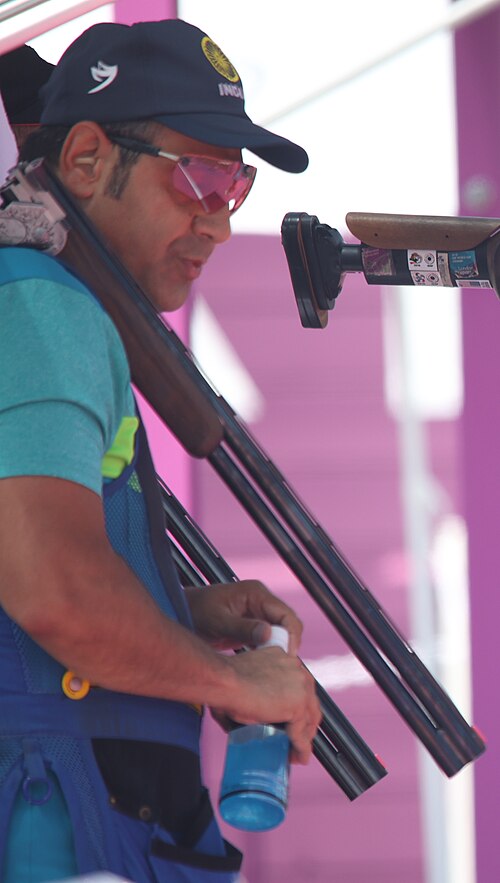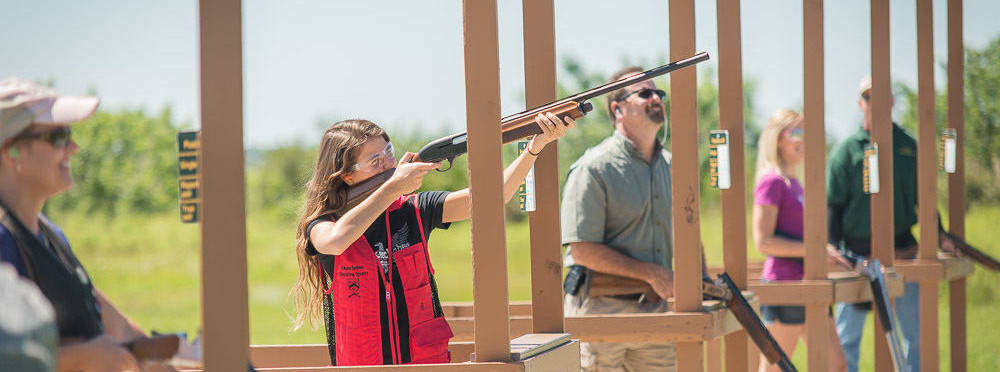Introduction to Shotgun Shooting
Trap
Trap is the oldest shotgun shooting sport in America. Trapshooting derives its name from the device, called a trap, which throws clay targets into the air. Participants shoot at the clay targets thrown from a trap house located in front of the shooter. The trap rotates in a random sequence, presenting the shooter with a variety of going away shots, angling to the right, left and flying straightaway. Trap is usually shot in squads of five shooters. A round of trap consists of 25 targets per shooter. A trap field has five positions, or stations, numbered consecutively from left to right. Five clay targets, sometimes referred to as “birds,” are thrown for each shooter at each position, with one shot being fired at each bird. After firing five rounds in rotation, each squad member moves one station to his right, with the shooter on station five moving over to station one.

Skeet
Skeet uses the same clay targets as trap. Two trap houses are required in skeet-a “high house” at the left of the field and a “low house” at the right. Both traps throw targets at fixed angles. High-house targets start at a point about 10 feet above the ground, moving to the shooter’s right. Low-house targets move in the opposite direction starting from a point about three feet off the ground.
Skeet is usually shot in squads of five shooters. A skeet field has eight positions, or stations, seven of which are numbered consecutively from left to right in a semi-circle around the field. Station eight is located in the center, almost directly between the trap houses, offering very challenging-and very exciting-targets.
A round of skeet consists of 25 targets. Some stations offer single targets, others doubles. There are 16 single targets, two from each station. A round also includes eight shots at four double-targets from stations 1, 2, 6 and 7. The first target missed is repeated; the repeat target is called “the optional.” If no miss occurs in the round of 24 shots, the optional is taken as a single target; usually shot from station eight.

Double trap
Double trap is a shotgun shooting sports, one of the ISSF shooting events. Participants use a shotgun to attempt to break a clay disk flung away from the shooter at high speed.
The layout of double trap shooting is similar to that of trap shooting. The shooter stands 16 yards behind the house that releases the targets. Two targets are released simultaneously from the house. They follow set paths, usually 35 degrees to left and right of straightaway. The shooter can take one shot at each target.
In international Double Trap competitions, the course of fire is 75 doubles for men and 60 doubles for women. As the men’s event enjoys Olympic status, it also involves a 25-double final for the top six competitors. The women’s event was taken off the Olympic program after the 2004 Summer Olympics. Final shooting for women was discontinued in international competition as a result.

Sporting Clay
Sporting clays is a challenging clay target game designed to simulate a variety of field-shooting situations. On a sporting clays course, shooters are presented with a wide variety of targets that duplicate the flight path of game birds, such as flushing, crossing, incoming and other angling shots.
Courses are laid out in natural surroundings and typically include five or more shooting stations. Like golf, shooters move from one station to the next to complete the course.
At
any station, targets may be thrown as singles, simultaneous pairs, following pairs (one target right after the other) or report pairs (the second target launched at the sound of the gun being fired at the first). To further challenge shooters, target size may vary from the standard trap/skeet clay bird to the smaller “midi” and “mini” targets, or a flat disc-shaped “battue” target. There are also “rabbit” targets, special clay disks that are thrown on edge to roll and skitter unpredictably across the ground.
Sporting clays allows for either a pre-mounted or low gun approach, and a full round usually consists of 50 or 100 targets (depending on the number of stations), with several targets normally thrown at each station.

